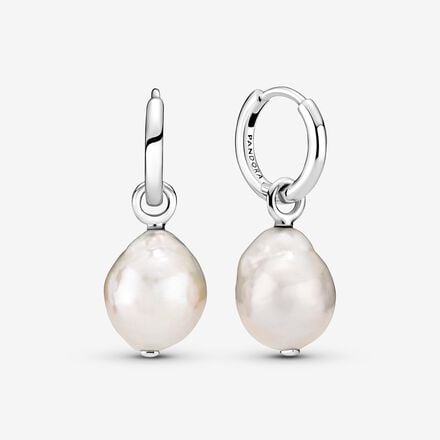Old Hollywood glamour? Sleek minimalism with a modern edge? Whatever aesthetic you're going for, pearls are your new best friend. From the simplicity of a single pearl drop earring to the extravagance of layered pearl necklaces, this material can do it all.
Our treated freshwater cultured pearl jewellery is here to add the finishing touch to your jewellery collection. From colours to care guidance, get clued up on all things pearls with our freshwater pearl jewellery guide.
How are freshwater pearls made?
Let's take a look at how natural freshwater pearls are made. When an irritant gets into the shell of the oyster or other mollusc, it begins to coat it with many layers of a pearly substance called nacre, eventually creating a lustrous pearl.
Unlike a natural pearl, a freshwater cultured pearl starts with human intervention. A skilled pearl technician gently inserts an irritant into the shell of a freshwater mussel. The mussels are then put into nets and submerged in the lakes surrounding the pearl farm.
The irritant in the shell grows to form a pearl sac in which the mother of pearl (nacre) is deposited layer upon layer until a pearl is formed. The longer the molluscs are left alone, the larger the pearl will grow. A freshwater mussel can create up to 50 cultured pearls at a time.
What’s the difference between cultured and freshwater pearls?
The term "cultured pearl" means genuine pearls produced with human assistance, as described above. There are two types of cultured pearls: freshwater and saltwater.
Freshwater pearls are harvested in lakes, rivers or ponds, while saltwater pearls come from the ocean. As saltwater pearls are more expensive, freshwater cultured pearls are great for everyday jewellery.
Freshwater pearl colours
Pandora's freshwater cultured pearls are treated through bleaching or dyeing to enhance or change the colour. Once harvested, white pearls are bleached, while coloured ones are dyed. Both types undergo a lustre-enhancing treatment
The most classic pearl colour is white or ivory, but thanks to dyeing technology, we can wear pearls in an array of lustrous colours. Some pearls also display an iridescent colour phenomenon known as "orient."
How to care for freshwater pearls
Treated freshwater cultured pearls are quite soft, with a hardness level of 2.5-4 on the Mohs scale, used to rate gem hardness. Because of this, they're prone to scratching and damage from acids, solvents, ultrasonic cleaning and dehydration.
Some dyed pearls may fade or revert to their original colour when exposed to sunlight or strong light. Here are our tips to keep your freshwater pearl jewellery looking great:
Ready to embrace the everlasting elegance of pearls? Discover the latest designs in our Pandora Essence Collection.


















